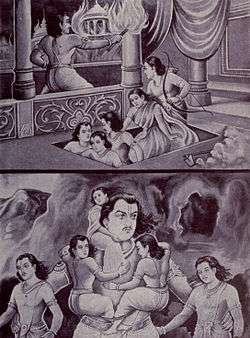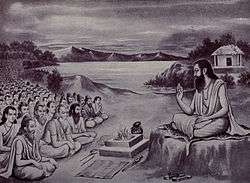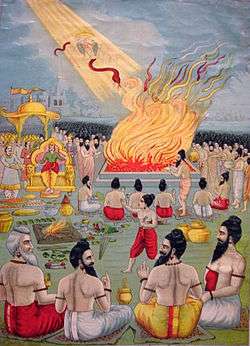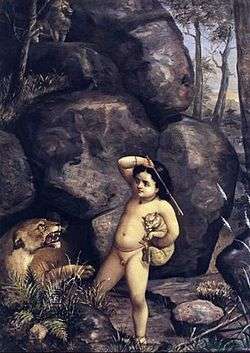Adi Parva
The Adi Parva or the Book of the Beginning is the first of eighteen books of the Mahabharata. आदि is a Sanskrit word that means first.
Adi Parva has 19 sub-books and 236 adhyayas(chapters). The critical edition of Adi Parva has 19 sub-books and 225 chapters.
Adi Parva describes how the epic came to be recited by Ugrasrava Sauti to the assembled rishis at the Naimisha Forest after first having been narrated at the sarpasatra of Janamejaya by Vaishampayana at Taxila. It includes an outline of contents from the eighteen books, along with the book's significance. The history of the Bhāratas and the Bhrigus are described. The main part of the work covers the birth and early life of the princes of the Kuru Kingdom and the persecution of the Pandavas by Dhritarashtra.
Structure & Chapters
The Adi Parva consists of 19 upa-parvas or sub-books(also referred to as little books). Each sub-book is also called a parva and is further subdivided into chapters, for a total of 236 chapters in Adi Parva. The names of 19 sub-books of Adi Parva, along with a brief of each sub-book:
- 1. Anukramanika Parva
- Sauti meets Rishis in a forest. They express a desire to hear Mahabharata. The parva describes the significance of Mahabharata, claims comprehensive synthesis of all human knowledge, and why it must be studied.
- 2. Sangraha Parva
- Outline of contents of 18 books of Mahabharata.
- 3. Paushya Parva
- Stories about Janamejaya, Aruni, Upamanyu, Utanka, Paushya and sage Dhaumya.
- 4. Pauloma Parva
- History of Bhargava race of men and Ruru. Story of Pauloma and Chyavana.
- 5. Astika Parva
- Mahabharata's version of churning of ocean to create the world. Theories on dharma, bondage and release. Story about snakes, Janamejya's vow to kill all snakes, step to annihilate them with a sacrificial fire, decision to apply Ahimsa(non-violence) to snakes and all life forms. Story of birth of Astika.
- 6. Adivansavatarana Parva
- History of Pandava and Kuru princes. Story of Bhishma, Satyavati, Karna, Vasudeva and Animandavya. Appeal to Brahma that gods should reincarnate to save the chaos that earth has become.
- 7. Sambhava Parva
- Theory of life on earth and gods. Story of Drona, Krona and other sages. The romance of Dushyanta and Sakuntala, their love marriage, birth of Bharata. Sakuntala goes to Dushyanta with the boy, he first refuses to remember her and their marriage, later apologizes and accepts. Bharata becomes prince. Stories of Devyani, Puru, Yadu and the Paurava race of men. The Pandava brothers retreat into the forest, their persecution by Dhritarashtra. The story about the Swayamvara of Kunti. Marriage of Madri, Vidura. Attempts to reconcile the conflict between Kauravas and Pandavas.
- 8. Jatugriha-daha Parva
- Kanika's counsel to Dhritarashtra on how to rule a kingdom, how deception is an effective tool for governance and war, against enemies and potential competition; Kanika's symbolic tale about jackal, tiger, mouse, mongoose and deer; his advice that a weak ruler should ignore his own weaknesses and focus on other people's weakness, pretend to be friends while being cruel and destructive to others, particularly when the competition is good and stronger. Dhritarashtra schemes to build a home for Pandavas in the forest, from lac and other inflammable materials as a friendly gesture, but with plans to burn them alive on the darkest night. Kanika's theory is called wicked and evil by Vidura, a sage of true knowledge and the good, who is also the advisor and friend to Pandavas. Vidura and Pandavas plan escape by building a tunnel inside the inflammable house. The fire, then escape of Pandavas. Dhritarashtra falsely believes Pandavas are dead.

- 9. Hidimva-vadha Parva
- After escape from fire, the wanderings of Pandava brothers. Story of Bhima and the she-Rakshasha Hidimba. She falls in love with Bhima and refuses to help her brother. The battle between Bhima and Hidimba's demon brother, showing the enormous strength of the giant brother Bhima. Bhima and Hidimba have a son named Ghatotkacha.
- 10. Vaka-vadha Parva
- The life of Pandavas brothers in Ekachakra. Story about Bhima slaying another demon Vaka, who has been terrorizing people of Ekachakra. Heroine of Mahabharata, Draupadi, is born in holy fire. Words spread that Pandavas may be alive.
- 11. Chaitraratha Parva
- Pandavas set out for Panchala. Story of Tapati, Vashistha and Vishwamitra. Dehumanization and persecution of Bhrigu race of men.
- 12. Swayamvara Parva
- Pandavas arrive in Panchala. Draupadi's swayamvara, Pandavas arrive in disguise, Arjuna and Bhima excel, win Draupadi's heart and hand, her marriage to Pandava brothers. Krishna introduced, recognizes the individuals in disguise are Pandava brothers.
- 13. Vaivahika Parva
- Drupada delights at discovering Pandavas are alive. Nuptials and marriage.
- 14. Viduragamana Parva
- Vidura's attempt to reconcile the evil Kaurava brothers and the good Pandava brothers. Various speeches by Karna, Bhishma, Drona and Vidura.
- 15. Rajya-labha Parva
- Return of Pandavas to Hastinapur, with blessings of Krishna. Construction of the city Indraprastha. Story about Sanda, Upasanda and Narada.
- 16. Arjuna-vanavasa Parva
- Arjuna violates dharma. He accepts voluntary exile. Arjuna marries Ulupi and Chitrangada, rescues Apsaras. Story highlights his special powers and competence. Arjuna and Krishna become close friends. Arjuna goes to Dwarka, lives with Krishna.
- 17. Subhadra-harana Parva
- Arjuna falls for and takes away Subhadra, Krishna's sister. Upset Vrishnis prepare war with Arjuna, but finally desist.
- 18. Harana-harika Parva
- Arjuna returns from exile, with Shubhadra. They marry. Their son Abhimanyu is born. Story about five sons of Draupadi.
- 19. Khandava-daha Parva
- The rule of Yudhishthira - theory and role of effective kings. Story of Varuna, Agni and Indra. The fight of Krishna(called Achyuta) and Arjuna with celestials, show of their combined abilities and victory.
English Translations

Adi Parva and other books of Mahabharata are written in Sanskrit. Several translations of the Adi Parva are available in English. To translations whose copyrights have expired and which are in public domain, include those by Kisari Mohan Ganguli and Manmatha Nath Dutt.

The translations are not consistent in parts and vary with each translator's interpretations. For example:
ययातीक्ष्वाकुवंशश्च राजर्षीणां च सर्शः|
सम्भूता बहवो वंशा भूतसर्गाः सविस्तराः||४५||
भूतस्थानानि सर्वाणि रहस्यं त्रिविधं च यत्|
वेदयोगं सविज्ञानं धर्मोऽर्थः काम एव च||४६||
धर्मकामार्थशास्त्राणि शास्त्राणि विविधानि च|
लोकयात्राविधानं च सम्भूतं दृष्टवानृषिः||४७||
इतिहासाः सवैयाख्या विविधाः श्रुतयोऽपि च|
इह सर्वमनुक्रान्तमुक्तं ग्रन्थस्य लक्षणम्||४८||विस्तीर्यैतन्महज्ज्ञानमृषिः सङ्क्षेपमब्रवीत्|
इष्टं हि विदुषां लोके समासव्यासधारणम्||४९||
मन्वादि भारतं केचिदास्तीकादि तथापरे|
तथोपरिचराद्यन्ये विप्राः सम्यगधीयते||५०||
विविधं संहिताज्ञानं दीपयन्ति मनीषिणः|
व्याख्यातुं कुशलाः केचिद्ग्रन्थं धारयितुं परे||५१||
तपसा ब्रह्मचर्येण व्यस्य वेदं सनातनम्|
इतिहासमिमं चक्रे पुण्यं सत्यवतीसुतः||५२||— Anukramanika Parva, Adi Parva, Mahabharata Book i.1
Translation by Manmatha Nath Dutt:
The wisdom of this work, like the stick used for applying collyrium,
has opened the eyes of the world which were covered by the darkness of ignorance.
As the sun drives away the darkness, so does this Bharata,
by its discourses on Dharma, Artha, Kama and Moksha, drive the ignorance of men.
As the full moon with its mild light opens the buds of the water-lily,
so does this with the light of Sruti expand the human intellect.
The whole house of the womb of nature is properly and completely lighted by the lamp of history which destroys the darkness of ignorance.
This work is a tree, the chapter of contents is its seed, the divisions Paulama and Astika are its roots, the Sambhava is its trunk,
the books(Parva) Sava and Aranya are the roosting perches, Arani is the knitting knot.
Virata and Udyoga the pith, Bhishma the main branch, Drona the leaves, Karna its beautiful flowers,
Sailya their fragrance, Stri and Aishika are its cooling shades, Shanti its great fruit.
Ashwamedha is its immortal sap, Asramavasika the place where it grows, and Mausula is the epitome of the Vedas.
This tree will be highly respected by all virtuous Brahmans. This tree of Bharata will be as inexhaustible as the clouds and be the means of livelihood of many illustrious poets.
Sauti continued: I shall speak to you about the ever lasting, fruitful and flowery productions of this tree. They are of pleasant and pure taste, and they are to be tasted even by immortals.— Anukramanika Parva, Translated by Manmatha Nath Dutt, Adi Parva, Mahabharata Book i.1
Translation by Kisari Mohan Ganguli:
The wisdom of this work, like unto an instrument of applying collyrium, hath opened the eyes of the inquisitive world blinded by the darkness of ignorance. As the sun dispelleth the darkness, so doth the Bharata by its discourses on religion, profit, pleasure and final release, dispel the ignorance of men. As the full-moon by its mild light expandeth the buds of the water-lily, so this Purana, by exposing the light of the Sruti hath expanded the human intellect. By the lamp of history, which destroyeth the darkness of ignorance, the whole mansion of nature is properly and completely illuminated.This work is a tree, of which the chapter of contents is the seed; the divisions called Pauloma and Astika are the root; the part called Sambhava is the trunk; the books called Sabha and Aranya are the roosting perches; the books called Arani is the knitting knots; the books called Virata and Udyoga the pith; the book named Bhishma, the main branch; the book called Drona, the leaves; the book called Karna, the fair flowers; the book named Salya, their sweet smell; the books entitled Stri and Aishika, the refreshing shade; the book called Santi, the mighty fruit; the book called Aswamedha, the immortal sap; the denominated Asramavasika, the spot where it groweth; and the book called Mausala, is an epitome of the Vedas and held in great respect by the virtuous Brahmanas. The tree of the Bharata, inexhaustible to mankind as the clouds, shall be as a source of livelihood to all distinguished poets."
Sauti continued, "I will now speak of the undying flowery and fruitful prodctions of this tree, possessed of pure and pleasant taste and not to be destroyed even by the immortals."
— Anukramanika Parva, Translated by Kisari Mohan Ganguli, Adi Parva, Mahabharata Book i.1
The total number of original verses depend on which Sanskrit source is used, and these do not equal the totalnumber of translated verses in each chapter, in both Ganguli and Dutt translations. Mahabharata, like many ancient Sanskrit texts, was transmitted across generations verbally, a practice that was a source of corruption of its text, deletion of verses as well as the addition of extraneous verses over time. Some of these suspect verses have been identified by change in style and integrity of meter in the verses. The structure, prose, meter and style of translations vary within chapters between the translating authors.
Debroy, in his 2011 overview of Mahabharata, notes that updated critical edition of Adi Parva, with spurious and corrupted text removed, has 19 sub-books, 225 adhyayas(chapters) and 7, 205 shlokas(verses).
Controversies

Adi Parva, and Mahabharata in general, has been studied for evidence of caste-based social stratification in ancient India, as well as evidence for a host of theories about Vedic times in India. Such studieshave become controversial.
First, the date and authenticity of the verses in Adi Parva, as well as the entire Mahabharata, has been questioned.Klaus Klostermaier, in his review of scholarly studies of Mahabharata, notes the widely held view that original Mahabharata was different from currently circulating versions. For centuries, the Mahabharata's 1, 00, 000 verses—four times the entire Bible and nine times the Iliad and the Odyssey combined—were transmitted verbally across generations, without being written down. This memorization and verbal method of transfer is believed to be a source of text corruption, addition and deletion of verses. Klostermaier notes that the original version of Mahabharata was called Jaya and had about 7000 shlokas or about 7% of current length. Adi Parva, and rest of Mahabharata, underwent at least two major changes - the first change tripled the size of Jaya epic and renamed it as Bharata, while the second change quadrupled the already expanded version. Significant changes to older editions have been traced to the first millennium AD. There are significant differences in Sanskrit manuscripts of the Mahabharata found in different parts of India and manuscripts of the Mahabharata found in other Indian languages such as Tamil, Malayalam, Telugu and others. Numerous spurious additions, interpolations and conflicting verses have been identified, many relating to history and social structure. Thus, it is unclear if the history or social structure of Vedic period or ancient India can be reliably traced from Adi Parva or Mahabharata.
Second, Adi Parva is part of an Epic fiction. Writers, including those such as Shakespeare or Homer, take liberty in developing their characters and plots, they typically represent extremes and they do not truthfully record extant history. Adi Parva has verses with a story of a river fish swallowing a man's semen and giving birth to ahuman baby after 9 months and many other myths and fictional tales. Adi Parva, like the works of Home and Shakespeare, is not a record of history.
Third, Adi Parva and other parvas of Mahabharata have been argued, suggests Klaus Klostermaier, as a treatise of symbolism, where each chapter has three different layers of meaning in its verses. The reader is painted a series of pictures through words, presented opposing views to various socio-ethical and moral questions, then left to interpret it on astikadi, manvadi and auparicara levels; in other words, as mundane interesting fiction, or as ethical treatise, or thirdly as transcendental work that draws out the war between the higher and the lower self within each reader.To deduce history of ancient India is one of many discursive choices for the interpreter.
Quotations & Teachings
_(6785807298).jpg)
Anukramanika Parva, Chapter 1:
Time creates all things
and time destroys them all.
Time burns all creatures
and time again extinguishes that fire.— Anukramanika Parva, Adi Parva, Mahabharata Book i.1
Tapa is not a sin,
Study is not a sin,
Ordinances of Vedas are not sins,
cquisition of wealth by exertion is not a sin,
When they are abused, then do they become the sources of evil.— Anukramanika Parva, Adi Parva, Mahabharata Book i.1
Sangraha Parva, Chapter 2:
As all the senses are dependent on the wonderful workings of the mind,
so all the acts and moral qualities depend on this treatise(Mahabharata).— Sangraha Parva, Adi Parva, Mahabharata Book i 2
Paushya Parva, Chapter 3:
You are the infinite, you are the course of Nature and intelligent soul hat pervades all,
I desire to obtain you through knowledge, derived from hearing and meditation.— Paushya Parva, Adi Parva, Mahabharata Book i.3
Adivansabatarana Parva, Chapter 62:
This (Mahabharata) is equal to the Vedas, it is holy and excellent,
it is the worthiest of all that should be listened to. It is a Purana, adored by the Rishis,
It contains many useful instructions on Artha and Kama. This sacred history makes the heart desire to attain salvation.— Adivansabatarana Parva, Adi Parva, Mahabharata Book i.62

Sambhava Parva, Chapter 73:
Dushyanta said to Sakuntala: Marry me according to the Gandharva form, for this form of marriage is said to be the best.
Sakuntala: O king, my father has gone from the hermitage to collect fruits. Kindly wait for a moment. He will bestow me upon you.
Dushyanta: O beautiful lady, O faultless beauty, I desire you yourself should accept me,
Know that I exist for you. Know also, my heart is completely in you,
One is certainly one's own friend, one can certainly depend on one's own self,
Therefore, according to the ordinance(scriptures), you yourself should bestow your own self on others.— Sambhava Parva, Adi Parva, Mahabharata Book i.73
Sambhava Parva, Chapter 74:
No man, even in anger, should ever do anything that is disagreeable to his wife;
for happiness, joy, virtue and everything depend on the wife.
Wife is the sacred soil in which the husband is born again,
even the Rishis cannot create men without women.
What is a greater happiness to a father than what the father feels when his son,
running to him, clasps him with his tiny little arms, though his body is full of dust and dirt.— Sambhava Parva, Adi Parva, Mahabharata Book i.74
Sambhava Parva, Chapter 79:
He who subdues his anger, he who does not regard the bad word of others,
he who is not angry even when there is a cause, certainly acquires the four objects for which we live(namely Dharma, Artha, Kama and Moksha).
Between the two men, one performing sacrifices continually every month for one hundred years and one who does not feel any anger,
the man who does not feel any anger is the greater man.
Boys and girls, who are incapable of distinguishing between right and wrong,
quarrel among one another; the wise never imitate them.— Sambhava Parva, Adi Parva, Mahabharata Book i.79
Sambhava Parva, Chapter 133:
Drupada said to Drona: Friendship never remains in the world in anyone's heart without being worn out,
Time wears it out, anger destroys it.
The poor cannot be the friend of the rich, the unlearned cannot be the friend of the learned,
the coward cannot be the friend of the brave, how then do you desire the continuance of our old friendship?— Sambhava Parva, Adi Parva, Mahabharata Book i.133
Viduragamana Parva, Chapter 206:
Drona said to Dhritarashtra: Friends summoned for consultation should always speak what is right, true.
— Viduragamana Parva, Adi Parva, Mahabharata Book i.206
See also
References
External links
- Sanskrit classics including Mahabharata Brown University Archives, with original, translations and commentaries by scholars
- Adi Parva Mahabharata, Translated by Manmatha Nath Dutt (1894)
- English Translation by Kisari Mohan Ganguli
- English Translation Readable, with various research tools, Translated by Kisari Mohan Ganguli, another archive
- Adi Parva in Sanskrit by Vyasadeva and commentary by Nilakantha (Editor: Kinjawadekar, 1929)
- French translation of Le Mahabharata, Adi Parva, by H. Fauche (Paris, 1868)
- A review of critical, less corrupted edition of Adi Parva by Vishnu S. Sukthankar; Reviewed by Franklin Edgerton, Journal of the American Oriental Society, Vol. 48, (1928), pages 186-190

